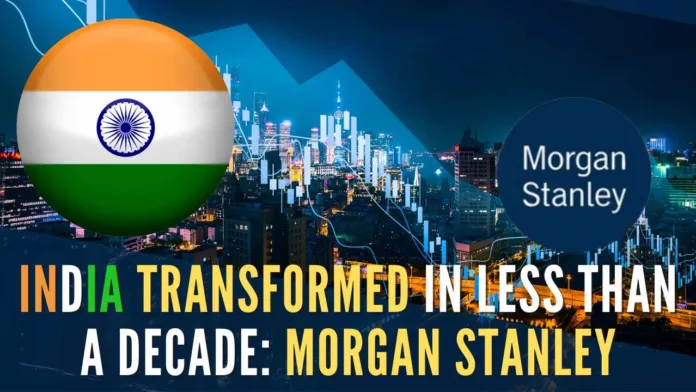
Morgan Stanley predicts India to emerge as a key driver for Asia and drive a fifth of global growth in the next decade
Latest report ‘India Equity Strategy and Economics: How India Has Transformed in Less than a Decade’ by Morgan Stanley, says that in a short span of 10 years, India has gained positions in the world order with significant positive consequences for the macro and market outlook.
The report lauded PM Narendra Modi-led government and has said that the position India gained today is mostly because of its policy choices, and their implications for its economy and market.
It has also predicted that India will emerge as a key driver for Asia and drive a fifth of global growth in the next decade.
“We have highlighted the 10 big changes, mostly because of India’s policy choices, and their implications for its economy and market. These are Supply-side Policy Reforms, Formalization of the Economy, Real Estate (Regulation and Development) Act, Digitalising Social Transfers, Insolvency and Bankruptcy Code, Flexible Inflation Targeting, Focus on FDI, India’s 401(k) Moment, Government Support for Corporate Profits, and MNC Sentiment at Multiyear High,” the report added.
“We run into significant skepticism about India, particularly with overseas investors, who say that India has not delivered its potential, despite its being the second-fastest-growing economy and among the top-performing stock markets over the past 25 years, and that equity valuations are too rich. However, such a view ignores the significant changes that have taken place in India, especially since 2014,” the report said.
While drawing the data for supply-side policy reforms, the research has gathered the figures related to India’s corporate tax at par with peers and infrastructure. In 10 years, India’s base corporate tax rate has stayed below 25 percent while for new companies with operations commencing before March 24, it has stayed at 15 percent.
In terms of infrastructure development, the report said there has been significant development in national highways, broadband subscriber base, renewable energy, and railway route electrified.
In the formalization of the economy, Morgan Stanley report has noted how GST collections, which were showing upward trends over the years, and digital transactions, which grew 76 percent of the GDP, have benefitted the economic growth.
The report has estimated that India will drive a fifth of global growth through the end of this decade. “India’s next decade will resemble China in 2007-11. GDP and Productivity Growth differentials will swing in India’s favour,” the report added.
On May 18, Morgan Stanley said India is poised to grow at 6.2 percent in the current financial year 2023-24 with improving macro stability indicating that the monetary policy will not have to turn restrictive.
In a report titled “Asia Economics: The Viewpoint: Addressing the Pushback to Our Constructive View“, authored by Chetan Ahya, Derrick Y Kam, Qiusha Peng, and Jonathan Cheung, Morgan Stanley said India enjoys tailwinds — both cyclical and structurally.
“We see healthy balance sheets sustaining the robust trends in domestic demand. Improving macro stability means the monetary policy will not have to turn restrictive, allowing the economic expansion to continue,” the report said.
PGurus is now on Telegram. Click here to join our channel and stay updated with all the latest news and views
For all the latest updates, download PGurus App.
- PM Modi launches another scathing attack on Congress; says ‘Rajiv Gandhi scrapped inheritance law to save family property’ - April 25, 2024
- TN: ED questions five district collectors in illegal sand mining case - April 25, 2024
- ECI issues show cause notice over alleged MCC violations by PM Modi, Rahul Gandhi; seeks response from BJP, Congress chief - April 25, 2024










